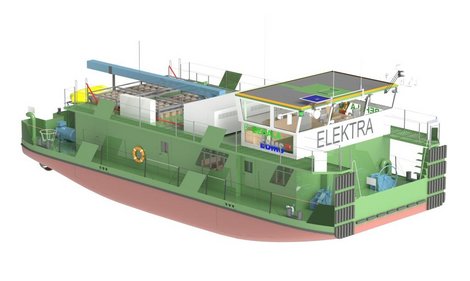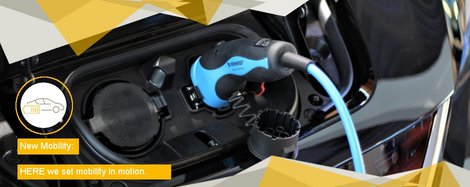Green Mobility on Rivers and Canals

© EBMS-TUB
Shipbuilders from Saxony-Anhalt are building the world’s first electric tug for inland waterways
The world’s first tug to run on battery power and hydrogen fuel cells is currently under construction at a shipyard in Derben on the River Elbe. Named ELEKTRA, the boat is one example of climate- and environment-friendly mobility from Saxony-Anhalt.
The future of transportation is emission-free – and not just on the road and in the air. It will soon encompass maritime transportation, too, both for goods and passengers. Companies from every corner of Saxony-Anhalt are rising to the challenge of the New Mobility strand in the state’s Regional Innovation Strategy.
And the Hermann Barthel shipyard in Derben, a district of Elbe-Parey, is among them. A family business founded over 200 years ago, it has built many vessels, some of them up to 80 meters long with a beam of 9 meters and a draft of up to 1.3 meters. The yard’s three-dozen or so workers are currently building an innovative all-electric tug for inland waterway transportation on the River Elbe, the River Havel and Berlin’s network of waterways. The tug, which weighs around 140 metric tons, is the first of its kind anywhere in the world.
It is based on plans and conceptual studies developed by a team of researchers led by Professor Gerd Holbach, Head of Dynamics of Maritime Systems at the Technical University of Berlin. Eight partners from university research departments and industry have come together to implement the project, including the Hermann Barthel Shipyard with support from other regional businesses. CEO Hermann Barthel wasted no time in getting on board when he was invited to join the pioneering fuel-cell tug project.
Elektra’s most remarkable innovation compared to conventional tugs is that it has no diesel engine, which means that it gives off no climate-damaging emissions such as carbon dioxide, diesel exhaust and nitrogen oxides. Thanks to cutting-edge lithium nickel manganese cobalt oxide batteries from the Netherlands and three low-temperature fuel-cells produced by a Canadian firm, the tug is capable of pushing up to 1,400 metric tons. The batteries, together with the six hydrogen pressure tanks, take up a large proportion of the deck area behind the wheelhouse. This means the 20-meter-long vessel will be some three meters longer than a conventional tug. But that’s not a problem. When attached to the 65-meter-long heavy cargo barge, Ursus, the convoy will be able to navigate all the channels between Berlin and Hamburg. “We anticipate that the tug will be able to travel the roughly 400-kilometer route pushing 1,400 metric tons without having to stop and recharge,” says Professor Holbach. This is because it has the option to switch to the three water-cooled fuel cells. In addition, solar panels on the roof will store electricity in the onboard power supply system. The tug has an ingenious driver assistance system to minimize energy consumption and keep it on schedule as closely as possible.
The customary tug crew of two to three people will still be required, but the only new training needed on top of the existing apprenticeship is the safe handling of hydrogen technology and lithium batteries.
ELEKTRA is due to be launched at the shipyard in Derben by the end of 2020. It will then be extensively tested on Berlin’s waterways and routes, starting out from its home port, Berlin West Harbour, where its future owner BEHALA (Berliner Hafen und Lagerhausgesellschaft) is headquartered. Going forward, the tug’s tasks will include delivering Siemens gas turbines – produced in Berlin and weighing several hundred tons – to the Port of Hamburg ready for export.
The practical test must prove that the electric tug is not only environment- and climate-friendly but also reliable and competitive compared to conventional inland freighters. If all goes well it may only be a few years before we see more zero-emission ships in European waters, potentially benefiting people and nature with not only cleaner air but also much lower noise pollution. Unlike conventional marine propulsion engines, fuel cells and batteries are virtually silent when running.
There are current discussions around developing and rolling out “tank stations” where “green” ships could recharge their hydrogen containers and batteries. The industrial port at Magdeburg-Rothensee is ideal for this, as the highway, rail and waterway networks converge in a trimodal hub. Professor Holbach anticipates that freight will not be the only maritime transportation segment to renounce marine diesel. Houseboats and passenger ferries might also see an increasing transition to emission-free drive technologies if political and economic conditions permit more green mobility.
Author: Uwe Seidenfaden/IMG Saxony-Anhalt
HERE we set mobility in motion.

The mobility of tomorrow is being conceived and tested in Saxony-Anhalt. HERE, components, systems and technologies are being developed as advance development for the automobiles that the OEMs will create tomorrow. And HERE procedures are optimised for new, manageable, and rapidly implementable technologies.
> Further information about New Mobility in Saxony-Anhalt HERE.
